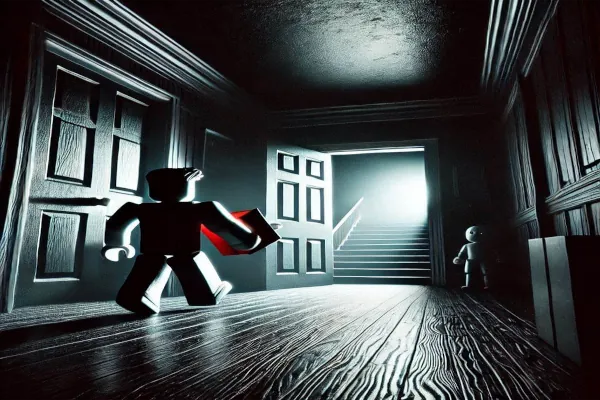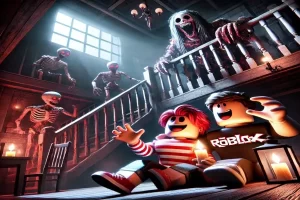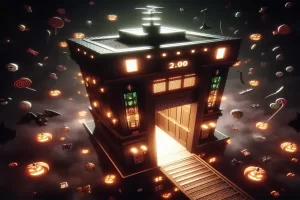Lighting is one of the most powerful tools in a game developer’s arsenal, especially within the horror genre. On Roblox, it’s used not only to create atmosphere but to manipulate player emotions, guiding their experience and enhancing the terrifying world around them. In horror games, lighting goes far beyond mere visual appeal; it serves as a psychological weapon that can shape the mood, control the pacing, and heighten fear.
In Roblox horror games, lighting plays an essential role in crafting an unsettling and immersive environment. Dimly lit corridors, flickering lights, and shadows lurking in the corners all contribute to a sense of mystery and dread. As players venture deeper into the unknown, the way light is used to reveal or conceal aspects of the environment amplifies their anxiety, making every step feel like a decision fraught with danger.
Explore how Roblox horror games expertly use lighting to guide players through their terrifying journey, subtly manipulating their actions and emotions, and ultimately creating a chilling experience where nothing is as it seems.
Understanding the Role of Lighting in Horror Games
Psychological Impact of Lighting
Lighting in horror games is far more than a design element; it’s a psychological tool that can evoke deep emotional responses from players. The way light is used can manipulate a player’s perception, creating feelings of unease, suspense, and vulnerability. The human brain is naturally wired to associate darkness and shadows with danger, triggering our fight-or-flight responses. In horror games, this connection is exploited, causing players to feel more alert and fearful as they navigate dimly lit environments.
Darkness often acts as a barrier, hiding threats that are just beyond sight, making every corner or hallway feel unpredictable and dangerous. In contrast, sudden bursts of light or the illumination of an eerie space can create moments of tension as players anticipate what’s lurking just out of view. This balance between light and shadow is what fuels the horror experience, making players constantly question whether the shadows conceal something waiting to pounce or if their next step will lead them into greater peril.
The Difference Between Horror and Non-Horror Lighting
Lighting in horror games is intentionally designed to be unsettling, unlike the bright, welcoming lighting used in non-horror genres. In more casual or action-packed games, lighting often serves to guide the player, highlight objectives, or create a sense of clarity and openness. However, in horror games, lighting is distorted to disorient and heighten tension.
For example, rather than illuminating every detail, horror games frequently employ shadows, flickering lights, or extreme contrasts between light and dark to obscure key visual elements. Dimly lit corridors, strobe-like lighting effects, or harsh contrasts between light and dark areas force the player to rely on their instincts, heightening the sense of dread. Shadows aren’t just a visual feature; they become an active element of fear, as players know something might be lurking just out of reach.
In essence, the lighting in horror games on Roblox (and elsewhere) is crafted to evoke fear and discomfort, whereas in other genres, lighting is meant to comfort and guide. The chilling, unpredictable nature of lighting in horror ensures that players are always on edge, never fully sure of what they’re walking into.
Lighting Techniques Used in Roblox Horror Games
Low Light and Darkness
In Roblox horror games, low light and complete darkness are some of the most powerful lighting techniques used to create an atmosphere of isolation and fear. When players are thrust into poorly lit environments, they are forced to rely on their limited vision, creating a sense of vulnerability. The inability to see clearly what’s ahead or behind them amplifies the tension, as players never know if danger is lurking in the shadows.
The psychological effect of darkness is simple yet profound: the human brain naturally associates darkness with the unknown, making it an ideal setting for fear. In these low-light environments, every sound and movement becomes heightened, and every corner feels like it could hide something terrifying. The lack of clarity in the surroundings forces players to rely on their senses, amplifying the feeling of being hunted or trapped in an unknown space, which is the core of horror gameplay.
Flickering and Dynamic Lighting
Flickering lights and dynamic lighting are used extensively in Roblox horror games to create an unstable, disorienting environment. The sudden shifts in brightness, with lights flickering on and off or changing in intensity, keep players on edge, never knowing when the next scare will strike. This creates a sense of unpredictability that is key to maintaining tension.
For example, a flickering light in an abandoned building may appear to offer a safe path, but the random intervals of darkness introduce an element of anxiety, as players feel they may be walking straight into danger. The changes in lighting can also indicate shifts in the game’s tone or the proximity of a threat. A sudden dimming of light may signify that something ominous is approaching, causing players to brace themselves for a scare. Dynamic lighting plays a crucial role in changing the mood as players progress through levels, often signaling shifts in the story or difficulty, amplifying the fear with each passing moment.
Spotlighting and Shadows
Spotlighting and the manipulation of shadows are other essential techniques in Roblox horror games. Spotlights direct the player’s attention to key areas or objects, but the effect is often sinister, as the concentrated light isolates the illuminated space while casting the rest of the environment in shadow. This creates a sense of anticipation, as players are forced to focus on what’s in the light, while the darkness surrounding them is filled with uncertainty.
Shadows, in particular, add an element of mystery or concealment. They can hide enemies or potential threats, making players second-guess their surroundings. The interplay of light and shadow can mislead players into thinking they are safe, only to have a shadow shift or flicker to reveal something terrifying. In horror games, shadows are not just visual effects; they are an active tool for creating tension, as they hide dangers and manipulate the player’s sense of security. The constant presence of shadows in Roblox horror games ensures that nothing is ever fully visible, keeping players in a state of constant unease.
These lighting techniques—low light, flickering, dynamic lighting, spotlights, and shadows—combine to create a deeply immersive and frightening atmosphere, heightening the horror experience by keeping players constantly on edge and uncertain of what awaits in the darkness.
Lighting and Narrative: Setting the Stage for Horror
Guiding the Player’s Focus
Lighting in Roblox horror games is a critical tool for guiding players through the game’s environment. Whether it’s a dimly lit hallway or a spotlight shining on a mysterious object, lighting is often used to direct the player’s attention to key areas, subtly hinting at where they should go or what they should avoid. This is particularly effective in games where the story is told through exploration, where lighting plays a role in steering the player toward important narrative moments or objects.
In many cases, lighting also serves to reveal or conceal parts of the story. A flickering light might hint at a hidden room, drawing attention to a seemingly innocuous part of the environment that may hold an essential clue or piece of lore. Conversely, lighting can also obscure crucial elements, keeping players in suspense and forcing them to work harder to uncover the truth. By controlling visibility, the game keeps players focused on the right areas while also ensuring they feel disoriented or uncertain in others, perfectly complementing the narrative’s twists and turns.
Creating Atmosphere Through Lighting
Lighting is one of the most effective ways to create the atmosphere that defines the tone of a Roblox horror game. Different lighting styles can instantly set the mood and transport players into a specific emotional space, enhancing the narrative with a sense of dread or unease. For example, cold, dim lighting might be used to create a chilling atmosphere in a haunted house, making the environment feel lifeless and oppressive. This lighting style emphasizes isolation, playing into the horror of being alone in a dark, abandoned space.
In contrast, warm flickering lights might be used in a decrepit asylum, offering a sense of discomfort and decay. The lighting can mimic the slow decay of the environment, suggesting that the horrors within the building have been festering for years. This type of lighting complements the game’s narrative by highlighting the dark history and tragic events tied to the location.
The way lighting is used also enhances the game’s overall theme. For example, a game set in a forest at night might employ moonlight and sparse artificial light to evoke feelings of mystery, while a factory setting might use harsh, industrial lighting to create an atmosphere of danger and tension. Each lighting choice is intentional, working alongside the story to amplify the player’s emotional response, whether it’s fear, curiosity, or suspense.
Lighting doesn’t just serve a visual function in Roblox horror games—it is essential in shaping the emotional landscape of the game. It establishes mood, guides gameplay, and deepens the player’s connection to the story, ensuring that every turn and corner feels like it holds a new terror waiting to be uncovered.
Lighting and Player Movement in Horror Games
Limiting Visibility and Enhancing Exploration
In Roblox horror games, lighting is often used to limit visibility, forcing players to move through the environment with caution. This limitation significantly increases the sense of vulnerability, as players are unable to see the entire area around them. Dim lighting or pitch-black darkness forces players to rely on minimal light sources, such as flashlights or flickering lamps, making them more vulnerable to threats lurking in the shadows. This adds a level of tension as players are constantly aware that danger could strike at any moment, especially when they can’t see what’s ahead or behind them.
The effect of shadows and partial visibility further enhances this sense of unease. In many games, shadows obscure parts of the environment, making it harder for players to assess what’s truly present around them. A barely visible figure in the distance or a silhouette in the corner of the room can keep players on edge, unsure whether it’s an enemy or just a trick of the light. The need to cautiously navigate through these shadowed spaces not only enhances the atmosphere but also creates a fear of the unknown, as players are unsure whether they’re walking into danger or simply exploring an empty area.
Anxiety Induced by Uncertainty
The use of poor lighting or deep shadows is a key tool in amplifying the sense of uncertainty and anxiety in Roblox horror games. When visibility is restricted, players are left uncertain about what lies ahead or what might be waiting for them just beyond the range of their flashlight. This uncertainty keeps players on high alert, as the fear of encountering something unexpected—whether it’s an enemy or a sudden environmental hazard—drives the tension.
Many Roblox horror games take advantage of this by strategically using limited light sources, such as dimly lit corridors or rooms where players must rely on single light sources that only illuminate a small part of the space. These games create scenarios where players must navigate tight spaces or explore dark corners, with the constant fear that something could be lurking just outside their vision.
For example, games like The Mimic or Doors use restricted lighting to make the player feel isolated and vulnerable, as they can’t see what’s behind the next door or around the next corner. The anticipation of what might be hidden in the darkness keeps players anxious, heightening the psychological horror and making every step forward feel like a tense decision.
The interplay between poor lighting and player movement is a cornerstone of Roblox horror design, using uncertainty and restricted visibility to make every moment feel suspenseful and terrifying. The combination of shadow, light, and limited vision ensures that players are always on edge, unable to fully relax, and constantly anticipating what might emerge from the darkness.
The Role of Light in Creating Suspense and Jump Scares
Building Suspense with Dark Corners and Shadows
Lighting plays a pivotal role in building suspense by manipulating shadows and dark corners, allowing Roblox horror games to effectively heighten tension. By keeping parts of the environment cloaked in darkness, players are forced to confront their fear of the unknown, never truly sure of what’s lurking in the shadows. These dark corners or poorly lit areas are often used to create anticipation—players know something is about to happen, but they can’t quite see what it is.
One common technique is to reveal only partial glimpses of monsters or hazards, which are often hidden in shadows. The slow reveal of terrifying creatures, facilitated by lighting, can be extremely effective in building a sense of dread. As players approach the edge of a dimly lit room or turn a corner into a pitch-black corridor, they are left in suspense, wondering if the next step will bring them face-to-face with a terrifying monster or simply an eerie empty space. This slow burn of anticipation before a jump scare can make the eventual reveal all the more unsettling.
By using lighting to conceal or distort objects in the environment, developers create a sense of vulnerability in players. The longer players are kept in the dark, both literally and figuratively, the more their fear grows. This gradual buildup of uncertainty and the tension it creates keeps players on edge, always wondering if danger is just around the corner.
Sudden Changes in Lighting During Key Moments
Lighting also plays a crucial role in jump scares, particularly when abrupt changes in lighting are used to intensify the shock. For example, lights suddenly turning off or flickering at the exact moment a monster appears amplifies the sense of danger and discomfort. These sudden shifts in lighting disrupt the player’s perception, making it harder for them to process what’s happening in the moment. The flickering of lights can create a disorienting experience where players are unsure if the environment is changing, if they are seeing things clearly, or if they are about to face an oncoming threat.
The effectiveness of this technique is heightened when it is combined with sound. Imagine a player walking through a corridor when the lights begin to flicker—accompanied by the sudden sound of creaking or a distant growl. This combination of light and sound creates a layered experience, heightening both the visual and auditory terror. The unexpected and abrupt changes in the environment force players to react quickly, increasing their heart rate and engagement as they prepare for what may be just around the corner.
These lighting shifts, often timed with key moments in gameplay, are an essential tool for creating genuine fear. Whether it’s a sudden blackout, a strobe effect, or the lighting slowly dimming as a monster approaches, lighting manipulations during jump scares are instrumental in keeping players on their toes and immersed in the horror. By using light to control what players can see and when they can see it, Roblox horror games are able to maintain a tight grip on the player’s emotions, delivering unforgettable moments of terror.
Case Studies: Lighting in Popular Roblox Horror Games
The Mimic: Light vs. Darkness
The Mimic stands out as a prime example of how lighting can be used to immerse players in a terrifying atmosphere. The game employs eerie, dim lighting throughout its various chapters, forcing players to explore dark corridors and environments filled with only the faintest glimmers of light. This constant play between light and darkness creates a sense of vulnerability, as players can never be sure of what’s hiding in the shadows.
Lighting in The Mimic is used strategically to guide or mislead players through its terrifying encounters. In many sections, the game directs players towards key areas with small pools of light, whether through flickering candles or spotlight effects. However, in other instances, lighting is used to mislead players, hiding dangers in the darkness just out of view. This combination of both guiding and misleading players through lighting creates a constant feeling of unease, as they never know if they’re walking towards safety or closer to a horrifying encounter.
The dim lighting enhances the psychological tension in The Mimic, making players feel exposed and fearful as they venture deeper into its dark and dangerous world. The shadows, ever-present and lurking in the corners of the screen, contribute to the paranoia, as the player is forced to confront the unknown at every turn.
Doors: Strategic Lighting for Tension
In Doors, lighting plays a crucial role in maintaining the tension and mystery throughout the game. Much of the experience is defined by low light and flickering effects that help to establish a sense of impending danger. The environment in Doors is often dimly lit, with the occasional flicker or blackout heightening the fear and suspense. These brief moments of dimness or flickering light leave players feeling unsure of what’s real and what’s a threat, increasing the feeling of dread as they progress through each level.
The game’s use of lighting does more than set the mood—it also serves to guide players through the environment. The faintest hints of light lead players down corridors or signal potential exits, but these subtle cues are often overshadowed by the fear that something dangerous could be lurking just beyond their vision. The unpredictable nature of these light effects keeps players on edge, never knowing when the next flicker or blackout will occur.
This strategic use of lighting creates a mysterious, ominous atmosphere where players can never quite let their guard down. It’s a constant reminder that the environment itself is an ever-changing entity, and players must navigate it carefully or risk falling victim to the horrors hidden in the darkness.
The Haunted Imperial Hotel: Lighting as a Tool for Fear
The Haunted Imperial Hotel is another Roblox horror game that expertly uses lighting to generate fear and uncertainty. In this game, the environments are filled with flashing lights, dark hallways, and long stretches of shadows that keep players in a state of constant tension. The use of flickering or dimming lights, particularly in critical moments, enhances the sense of unease, making players feel like something is always on the verge of happening.
The game strategically utilizes darkness to create uncertainty. Hallways and rooms are often plunged into near-complete darkness, forcing players to rely on what little light they can find. This limited visibility increases anxiety, as players are aware that they can be attacked at any moment, but are unable to fully see what’s around them.
The use of shadows is also key in The Haunted Imperial Hotel, with areas bathed in darkness providing perfect cover for lurking enemies. This lighting manipulation not only builds suspense but also plays with the players’ perception, making them question whether what they see in the darkness is real or a trick of the light. By continually shifting the lighting throughout the game, The Haunted Imperial Hotel maintains a high level of fear and uncertainty, ensuring that players are always on edge.
Conclusion
Lighting plays a pivotal role in shaping the fear and suspense that define Roblox horror games. Whether it’s the stark contrast between light and darkness, the unsettling flicker of lights, or the strategic use of shadows to hide lurking dangers, lighting is not just a visual tool but a powerful narrative device that drives the atmosphere of terror. By manipulating light, these games create environments that pull players into their eerie worlds, making every corner feel unpredictable and every moment filled with tension.
Beyond its visual impact, lighting is essential for guiding players’ emotions, enhancing their immersion, and amplifying the psychological elements of horror. It manipulates player perception, heightening the anticipation of jump scares, and constantly reminds them that the world around them is fraught with danger. Lighting works hand in hand with other elements like sound and gameplay to create a truly unforgettable horror experience.
The next time you dive into a Roblox horror game, take a moment to appreciate how lighting contributes to the fear you feel. Pay attention to how it shapes your experience, guides your actions, and builds suspense at every turn. Lighting is an often-overlooked but crucial element in crafting a truly terrifying game, and by noticing its subtle power, you can gain a deeper understanding of what makes these games so spine-chilling.




